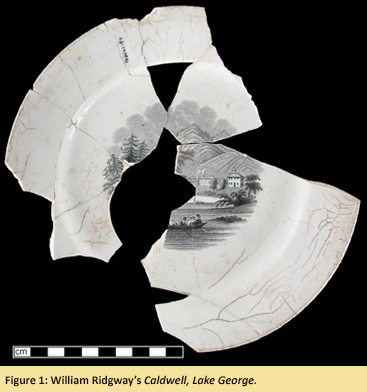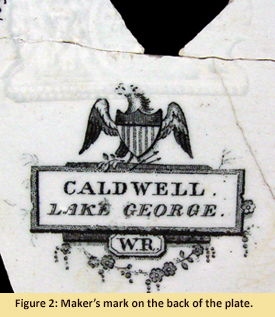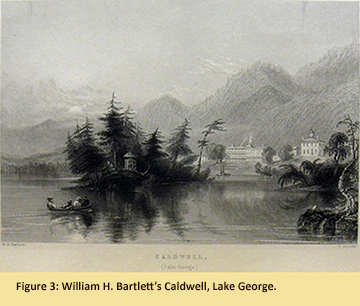The Mystery of Lake George
August 2012
By Sharon Osofsky, MAC Lab Intern

In the spring of 1980, the Mid-Atlantic Archaeological Research Inc. excavated a site of former row houses and their backyards in Baltimore City, where construction was going to break ground for a Federal Reserve Bank. Within five weeks, all of the excavations were completed, revealing wells, privies, and other areas where structures used to exist. Recent analysis on one of the privy features, Feature 17, revealed a printed white earthenware plate that yielded clues about the early copying of drawings in the United States. The pieces of ceramic not only mend together to show a depiction of a mountain lake scene, but a maker's mark and the name of the scene were also present on the back side of the plate.
The back of the plate had a printed mark of an eagle and two boxes as well as a partial impressed mark of a lion. One of the boxes contains the printed words "Caldwell, Lake George" while the other box contains "W.R.". With the maker's mark of a "W.R.", it has been determined that the Staffordshire pottery firm of William Ridgway manufactured this ceramic vessel between the years of 1830-1834 (Godden 1964:538). The words "Caldwell, Lake George" give the name of a town and lake in the Adirondack Mountains of New York. The other partial mark of the lion suggests that the plate was impressed with the British royal seal of a lion and unicorn.
 After the War of 1812, many Staffordshire potters appealed to the American market by creating scenes depicting North American landmarks, like churches, government buildings and hotels and resorts as well as city vistas (Samford 1997:65). Published prints were the primary sources for these American views; since no copyright laws were in existence prior to 1842, it was legal and acceptable for the Staffordshire potters to copy book and other printed illustrations (Samford 1997). For the Lake George plate, the question becomes "what engraving or print did William Ridgway copy in order to make this plate?" Other questions explored here include who first created the illustration and the publication date of the original print.
After the War of 1812, many Staffordshire potters appealed to the American market by creating scenes depicting North American landmarks, like churches, government buildings and hotels and resorts as well as city vistas (Samford 1997:65). Published prints were the primary sources for these American views; since no copyright laws were in existence prior to 1842, it was legal and acceptable for the Staffordshire potters to copy book and other printed illustrations (Samford 1997). For the Lake George plate, the question becomes "what engraving or print did William Ridgway copy in order to make this plate?" Other questions explored here include who first created the illustration and the publication date of the original print.
The earliest depiction found so far comes from a plate, decorated with a gold border and landscape design identical to the Ridgway pattern, manufactured by the Coalport Factory during a ten-year span of 1820-1830. The title of the porcelain plate was "Caldwell, Lake George, America" (Plate Caldwell). The Coalport firm produced high-end expensive British porcelain that was embellished with lots of gold gilt. By the time William Ridgway's firm produced the "Caldwell, Lake George" pattern, they used much less expensive white earthenware and no gilt.
 In 1840, Nathaniel P. Willis published American Scenery: Or Land, Lake, and River Illustrations of Transatlantic Nature (Willis 1840). One of the illustrations in this book was British landscape artist William H. Bartlett's (1809-1854) 1837-1838 drawing of "Caldwell, Lake George" (William H. Bartlett Prints 2010). In 1846-1847, Kellogg and Thayer published a lithograph of the same engraving with some minor differences (Views of the… 2012). The question comes to when the print of Caldwell, Lake George was first produced.
In 1840, Nathaniel P. Willis published American Scenery: Or Land, Lake, and River Illustrations of Transatlantic Nature (Willis 1840). One of the illustrations in this book was British landscape artist William H. Bartlett's (1809-1854) 1837-1838 drawing of "Caldwell, Lake George" (William H. Bartlett Prints 2010). In 1846-1847, Kellogg and Thayer published a lithograph of the same engraving with some minor differences (Views of the… 2012). The question comes to when the print of Caldwell, Lake George was first produced.
Since no copyright acts existed before 1842, it is almost impossible to tell when the first depiction was produced and who produced it. If William H. Bartlett was the first person to create a drawing of Caldwell, Lake George, then the dates assigned to the William Ridgway and the Coalport plates are incorrect and too early by one or more decades. Then, Kellogg's and Thayer's 1846-1847 lithograph could have the correct date and they probably received permission to create the lithograph. If the dates for both pieces of pottery are correct, then it might be a mystery about who produced the picture first, because the possibility exists of Bartlett copying his drawing from someone else. Hopefully, new sources in the future will become known and help solve this mystery.
| References |
|
| Godden, Geoffrey A. |
| 1964 |
Encylopaedia of British Pottery and Porcelain Marks. London: Barrie and Jenkins. |
|
| "Plate Caldwell, Lake George, America." The AMICA Library. Accessed July 10, 2012. |
|
http://amica.davidrumsey.com/luna/servlet/detail/ AMICO~1~1~44892~77680:Plate-Caldwell,-Lake-George,-Americ?sort=INITIALSORT_CRN%2COCS%2CAMICOID&qvq=q:AMICOID%3DFASF.138480%2B;sort: INITIALSORT_CRN% 2COCS%2CAMICOID; lc:AMICO~1~1&mi=0&trs=1. |
|
| Samford, Patricia |
| 1997 |
"Response to a Market: Dating English Underglaze Transfer-Printed Wares." Historical Archaeology 31, no. 2:1-30. |
|
| "Views of the Adirondack Region of New York." The Philadelphia Print Shop, LTD. Last modified May 24, 2012. |
|
http://www.philaprintshop.com/adirondack.html. |
|
| "William H. Bartlett Prints 1837-1842." New York State Library. Last modified April 06, 2010. |
|
http://www.nysl.nysed.gov/msscfa/pri5584.htm. |
|
| Willis, Nathaniel Parker |
| 1840 |
American Scenery; Or, Land, Lake, and River Illustrations of Transatlantic Nature. London: George Virtue. |
|